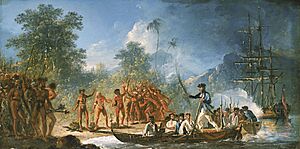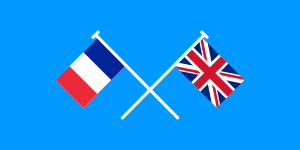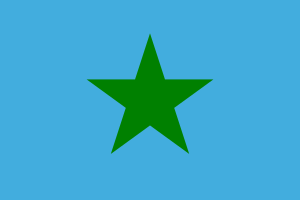History of Vanuatu facts for kids
The history of Vanuatu tells us about the islands and their people over more than 3,200 years. It's a story of ancient cultures, European explorers, and how the nation became independent.
Contents
Ancient History of Vanuatu
The story of Vanuatu before Europeans arrived is put together using clues from different studies. These include looking at languages, old cultures, things found by archaeologists, and even human DNA.
Archaeological finds show that people speaking Austronesian languages first came to these islands about 3,300 years ago. They left behind pieces of pottery that are about 3,300 years old.
The very first people in Vanuatu were part of the Lapita culture. They spoke an early language called Proto Oceanic. Later, around 500 BC, another group of Melanesian people likely arrived.
Around the 1500s or 1600s, a very important leader named Roi Mata lived. He brought together several different tribes in central Vanuatu. He was buried in a large mound with some of his followers. This burial site is now a UNESCO World Heritage Site, which means it's a special place recognized globally. People in Vanuatu still share stories and legends about Roi Mata today.
European Explorers Arrive

The islands of Vanuatu were first visited by Europeans in 1606. A Portuguese explorer named Pedro Fernandes de Queirós, sailing for the Spanish king, landed on the largest island. He thought he had found a huge southern continent and named the islands La Austrialia del Espiritu Santo, meaning "The Southern Land of the Holy Spirit." The Spanish tried to set up a small settlement there, but it didn't last long. The name Espiritu Santo is still used for the island today.
Europeans didn't return for many years. In 1768, Louis Antoine de Bougainville visited the islands and called them the Great Cyclades. Then, in 1774, Captain Cook explored the islands and gave them the name New Hebrides. This name stuck for a long time, until the islands became independent.
Changes and Challenges
In 1825, a trader named Peter Dillon found valuable sandalwood on the island of Erromango. This started a rush for the wood, but it ended in 1830 after conflicts between immigrant Polynesian workers and the local Melanesian people.
During the 1860s, plantation owners in places like Australia and Fiji needed many workers. They started a system called "blackbirding." This involved taking people from the islands to work on plantations, often against their will, under long-term contracts. At one point, more than half the adult men from some islands were working abroad. It's believed that the population of Vanuatu was much larger before Europeans arrived.
Around this time, missionaries from both Roman Catholic and Protestant churches also came to the islands. For example, John Geddie, a Scottish-Canadian missionary, arrived on Aneityum island in 1848. He spent his life there, working to introduce Christianity and Western ways.
Settlers also came to buy land and start cotton plantations. When cotton prices dropped, they switched to growing coffee, cocoa, bananas, and especially coconuts. At first, most settlers were British from Australia. But after 1882, a French company called the Compagnie Caledonienne des Nouvelles Hebrides was formed. This led to more French settlers arriving. By the early 1900s, there were twice as many French settlers as British ones.
Franceville: A Unique Experiment
The town of Franceville, which is now Port Vila on Efate island, was created during this time. In 1878, Britain and France agreed that the New Hebrides would be a neutral territory. However, without a clear government, there were problems between the British and French settlers. For example, French law required marriages to be done by a government official, but the closest one was in New Caledonia. British law allowed local church leaders to perform marriages.
To help their citizens, both nations set up a Joint Naval Commission in 1887. On August 9, 1889, Franceville declared itself independent! It had its own mayor, Ferdinand Chevillard, and a red, white, and blue flag with five stars. This community was one of the first places to allow everyone to vote, no matter their gender or race. However, only white settlers could hold office.
The Condominium Government

Because both French and British people had interests in the islands, there were requests for one of the powers to take control. The 1887 agreement only set up a joint naval commission to protect citizens. It didn't have power over the local people's affairs.
However, in 1906, France and the United Kingdom decided to rule the islands together. This was called the British-French Condominium. It was a very unusual type of government because it had two separate systems that only came together in a joint court. The Condominium's power was made stronger in 1914. Under this system, Melanesian people could not become citizens of either Britain or France. They were officially stateless. To travel, they needed a special ID signed by both the British and French officials.
Many people called the Condominium the "Pandemonium" because everything was duplicated. There were two sets of laws, two police forces, two prisons, two currencies, and two education and health systems. Visitors could choose between British law, which was seen as stricter but had better prisons, or French law, which was less strict but had worse prisons.
During the 1920s, it was said that plantation owners would gamble using the "years of labor" of their Melanesian workers as money. Islanders were sometimes lined up against a wall, and their future depended on the throw of dice.
During World War II, about 10,000 Ni-Vanuatu men joined the Vanuatu Labor Corps. They helped the United States Armed Forces at a base on Espiritu Santo. Their involvement in the war had a big effect on the John Frum movement, which became a religion and a political party.
Road to Independence
One of the main reasons for seeking independence was the issue of land ownership, which became very important in the 1960s. The traditional customs of the Ni-Vanuatu people meant that land was held for future generations by those currently living on it. However, Europeans saw land as something to buy and sell. They owned about 30% of the land, mostly cleared for coconut farming. When they started clearing more land, protests began on Santo and Malekula. These protests were led by Jimmy Stevens and his kastom (custom) movement called "Nagriamel."
In the 1960s, France did not want the New Hebrides to become independent. They worried that independence would spread to their other colonies, especially New Caledonia, which had valuable minerals.
The first political party was formed in the early 1970s. It was first called the New Hebrides National Party. One of its founders was Walter Lini, an Anglican Priest, who later became the first prime minister of Vanuatu. The party was renamed the Vanua'aku Party in 1974 and strongly pushed for independence. A new assembly was created in 1975, but it was dissolved in 1977 after people demanded immediate independence. In 1979, foreign landowners were compensated by their own governments, and a date was set for full independence.
France was not happy about this. There were significant rebellions on Tanna and Espiritu Santo. Documents later showed that France had secretly supported these rebellions, hoping Espiritu Santo would become a separate French colony. A French representative even managed to be recognized as King of Espiritu Santo by some tribal chiefs.
The "Coconut War"
In June 1980, Jimmy Stevens, the leader of the Nagriamel movement, started an uprising against the colonial government and the plans for independence. The uprising lasted about 12 weeks. The rebels blocked the airport, destroyed two bridges, and declared Espiritu Santo island independent as the "State of Vemerana." Stevens was supported by French-speaking landowners and by the Phoenix Foundation, an American group that wanted to create a libertarian tax haven in the New Hebrides.
On June 8, 1980, the New Hebrides government asked Britain and France to send troops to stop the rebellion on Espiritu Santo. France refused to let the United Kingdom send troops, and French soldiers already on Espiritu Santo did nothing. As independence day got closer, the Prime Minister-elect, Walter Lini, asked Papua New Guinea for help. When soldiers from Papua New Guinea started arriving on Espiritu Santo, the news media began calling the events the "Coconut War."
However, this "war" was short and unusual. The people of Espiritu Santo generally welcomed the Papua New Guineans as fellow Melanesians. Stevens' followers were armed mostly with bows and arrows, rocks, and slings. There were very few injuries. The "war" ended suddenly when a vehicle carrying Stevens' son crashed through a Papua New Guinean roadblock. Soldiers fired at the vehicle, killing Stevens' son. Soon after, Jimmy Stevens surrendered, saying he never wanted anyone to be harmed.
At Stevens' trial, it was revealed that the Phoenix Foundation had supported the Nagriamel movement. It also came out that the French government had secretly helped Stevens. Stevens was sentenced to 14 years in prison and was released in 1991.
Independent Vanuatu
On July 30, 1980, even while the short "Coconut War" was happening, the Republic of Vanuatu became an independent nation.
Since independence, only kastom (customary) owners and the government can own land. Foreigners and other islanders who are not kastom owners can only lease land for a maximum of 75 years, which is considered the productive life of a coconut palm.
During the 1990s, Vanuatu went through a time of political changes. This led to a government where more power was given to local areas. In 1996, the Vanuatu Mobile Force, a paramilitary group, tried to take control because of a pay dispute. There were also claims of corruption in the government. New elections have been held many times since 1997, with the most recent one in 2016.
See also
 In Spanish: Historia de Vanuatu para niños
In Spanish: Historia de Vanuatu para niños





